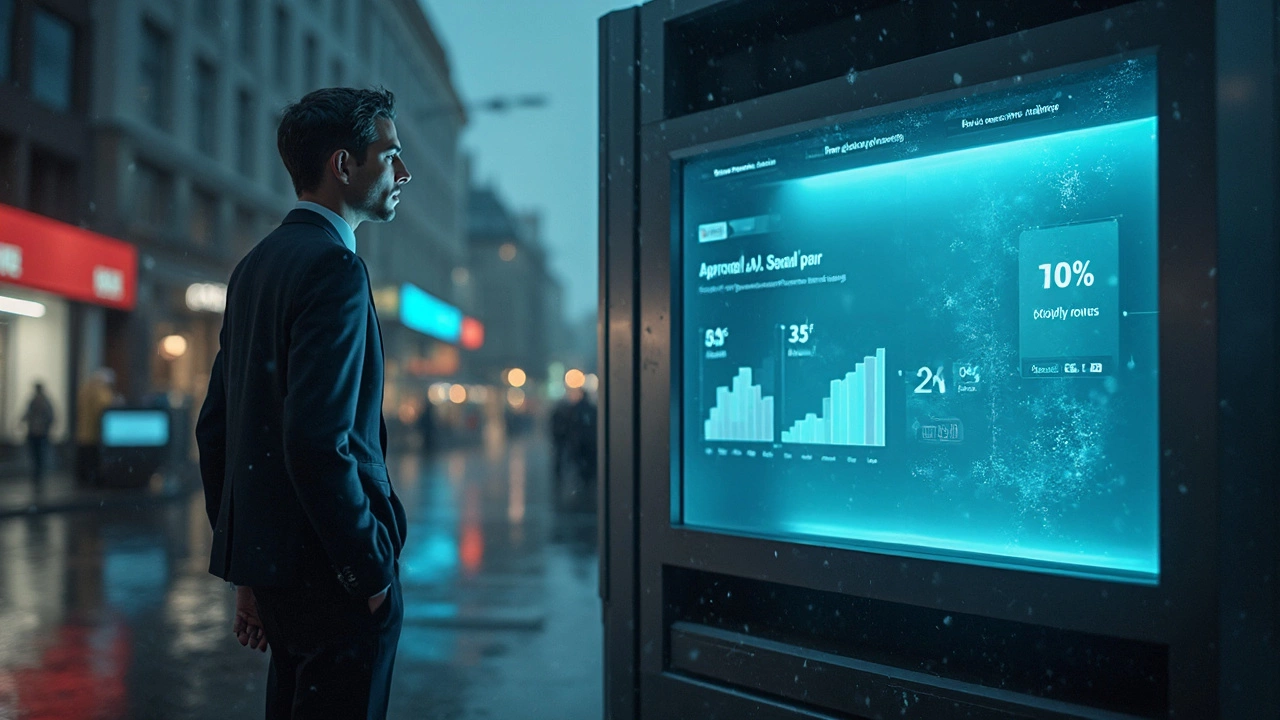Upstart Risks: What You Need to Know Before Taking a Personal Loan
 May, 20 2025
May, 20 2025
Most people hear about Upstart and think, 'Hey, here's a clever shortcut to a personal loan.' After all, the platform uses artificial intelligence to approve borrowers, even if your credit score isn’t perfect. Sounds smart, right? But here’s the kicker—the same tech that can get you money fast can also catch you off guard.
People usually focus on how easy it is to apply and how quick the cash lands in their bank. Few stop to ask: what if Upstart’s algorithm gets it wrong? Or what if those lower advertised interest rates aren’t what you actually get? The truth is, Upstart loans aren’t one-size-fits-all, and the risks go beyond just ‘will I get approved or not?’
This isn’t just about fine print, either. We’re talking about potential extra costs, surprise impacts on your credit report, and even how your job history or college degree could be used in ways you don’t expect. If you’re thinking about borrowing with Upstart, it pays to know where the potholes might be. Let’s get real about the downsides before you click ‘apply.’
- How Upstart Approves Loans
- The Fine Print: Interest Rates and Fees
- Unexpected Credit Impacts
- Tips for Safer Borrowing on Upstart
How Upstart Approves Loans
So, here’s what makes Upstart different from other lenders: they use artificial intelligence to decide who gets a loan. Instead of looking just at your credit score, Upstart’s system checks out a bunch of extra stuff—your education, your current job, income, and even your field of study. They say this helps them find good borrowers who might get rejected by old-school banks.
Here’s how the approval process works:
- You fill out a quick online application, sharing details like your age, where you work, your education, and how much you want to borrow.
- Upstart’s algorithm pulls your credit report and merges it with info you share. It even looks at public data to help make a prediction.
- They measure the chance you’ll repay the loan using their AI model. This includes checking your debt-to-income ratio, employment status, and any recent credit events (like late payments or bankruptcies).
- Within minutes, you’ll find out if you’re approved and what your loan offer looks like.
This all sounds quick and easy, but here’s the reality—AI models aren’t perfect. They might lean heavily on your background, which sometimes means a college grad in a high-paying field gets a break, while someone with years of solid work but without a flashy degree might miss out. And if the algorithm misreads something, there’s not much you can do to appeal.
If you’re wondering whether a human ever checks your details, the answer’s mostly no. Unless there’s a red flag or missing info, it’s all machine-driven. That can be great for speed, not so much if you’re hoping for a second opinion.
Here’s a look at Upstart approval data from recent years:
| Year | Approval Rate (%) | Average Credit Score | % with Limited Credit History |
|---|---|---|---|
| 2022 | 23 | 670 | 27 |
| 2023 | 21 | 674 | 24 |
Notice those approval rates? Not as high as you’d expect with all that tech doing the work. Bottom line: while Upstart risks are tied to their clever use of AI, that same approach can sometimes miss people who’d be great borrowers. It’s a fast process, but not always a fair one.
The Fine Print: Interest Rates and Fees
Here’s where a lot of folks get tripped up—interest rates and hidden fees. Upstart talks a big game about fast approval and using smart tech, but you have to read every detail. As of 2025, Upstart’s personal loan rates range anywhere from 7.8% all the way up to a whopping 35.99% APR. That’s a huge difference, and your rate could swing high even if you’re just an average borrower.
Think you’ll always get the low rates in the ads? Not a chance. Your Upstart risks go up if the algorithm ranks you as a higher risk, maybe just because you don’t hold a four-year degree or you’ve switched jobs a few times. One thing is for sure, always double-check the actual offer—don’t get blinded by the lowest number you see online.
"Upstart’s model causes borrowers to sometimes see rates much higher than expected—read all disclosures, or you could be paying double what you planned." — Marketplace.org, Loan Tech Special
Beyond the interest, there are fees you probably weren’t expecting. Upstart charges an origination fee that can gobble up to 12% of your loan amount right off the top. Plus, there’s a $15 late fee if your payment shows up even a day after the due date. Want to pay by paper check? That’s another $5 charge each time.
- Origination fee: 0% - 12%
- Late payment fee: $15 or 5% of the past due amount, whichever is greater
- Paper check fee: $5
- No prepayment penalty (at least there’s that)
Let’s lay it out in a quick table so you can see how this stacks up to other popular lenders:
| Lender | APR Range | Origination Fee | Late Fee |
|---|---|---|---|
| Upstart | 7.8%–35.99% | 0%–12% | $15 or 5% |
| LendingClub | 8.98%–35.99% | 2%–6% | $15 or 5% |
| SoFi | 8.99%–25.81% | 0% | $5 |
The bottom line: Upstart can work well for the right person, but if you gloss over the fine print, your so-called cheap loan could cost way more than you bargained for. Always use their rate-check tool for a real quote, and read everything before you hit accept. No shortcuts here.

Unexpected Credit Impacts
Taking a loan with Upstart can feel like scoring an easy win, but your credit score could take a hit in ways you didn’t expect. When you apply, Upstart does a “soft pull” at first, which doesn’t ding your score just to get a rate quote. But if you actually go through and accept the loan, they run a “hard pull” that shows up on your credit report. Too many hard pulls in a short time? Lenders see that as risky, and your score drops—sometimes by a few points, sometimes by more.
Now, here’s another wrinkle: once you accept an Upstart loan, your total debt goes up and that can change your credit utilization. Even though personal loans are “installment” debt (not revolving debt like your credit cards), adding more debt can still shift how lenders view you. If you already have loans or credit cards, new debt can push your DTI (debt-to-income) ratio higher—and banks look at that big time when you want a mortgage or car loan later on.
And don’t forget about your payment history. Miss a payment with Upstart and, according to FICO, “a single payment that’s 30 days late can lower a credit score by as much as 100 points.” That’s brutal. Keeping up with payments is key to protecting your credit while juggling any loan.
"Opening several new credit accounts in a short period of time represents greater risk—especially for people who don’t have a long credit history," says Experian, one of the major credit bureaus.
Here’s a quick checklist for keeping your Upstart risks low and your score safe:
- Only apply if you’re serious about accepting an offer—don’t shop around for fun.
- Keep your total borrowing in check so your debt-to-income ratio doesn’t balloon.
- Set reminders to pay on time, every time—late payments hurt fast and hard.
- Check your credit report after you get your loan, just to catch any errors early.
Tips for Safer Borrowing on Upstart
If you’re thinking about jumping into a loan with Upstart, you’ll want to play it smart. Upstart uses lots of data, including your education and work history, not just your credit score. That means things like your college major or how steady your job is can actually change your odds or the interest rate you get. It’s slick, but it can trip you up if you don’t read the details.
Before you even start the application, grab your most recent credit report. Look for errors that could hurt your chances or make your Upstart risks worse. Even a small mistake can mean a higher rate or less money offered.
- Shop around. Upstart isn’t the only player in town. Use soft credit checks to compare offers from other lenders like SoFi, LendingClub, or Marcus. Sometimes a lower rate or fewer fees are just a click away.
- Read every fee. Upstart often charges an origination fee—sometimes up to 12% of the loan. That comes out of your funds right away. Don’t get surprised. Ask yourself how much money you’ll actually receive after fees are subtracted.
- Don’t borrow more than you need. Upstart lets you borrow up to $50,000, but only take what you can comfortably pay off. Bigger loans mean bigger monthly payments and more interest over time.
- Watch your payment schedule. Upstart’s late fee policy kicks in after 15 days. If you’re late, you’ll pay at least $15 or 5% of the unpaid amount—whichever is greater. Set reminders or use autopay to avoid this kind of hit.
Heads-up: Accepting a loan will do a hard pull on your credit. If you’re planning to make other big credit moves soon, like buying a car or house, keep this timing in mind. Lastly, if you’re having second thoughts after approval, there’s a three-day window to cancel with no penalty—so don’t feel rushed by the ticking clock on your offer.
Bottom line—read every line of your agreement, know all your options, and don’t let a fast approval cloud your judgment. Upstart can help in a pinch, but it pays to keep your eyes wide open the whole way.
